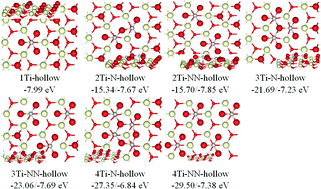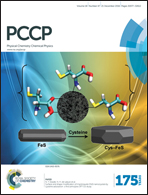Effects of strong interactions between Ti and ceria on the structures of Ti/CeO2†
Abstract
The effects of strong interactions between Ti and ceria on the structures of Ti/CeO2(111) are systematically investigated by density functional theory calculation. To our best knowledge, the adsorption energy of a Ti atom at the hollow site of CeO2 is the highest value (−7.99 eV) reported in the literature compared with those of Au (−0.88–−1.26 eV), Ag (−1.42 eV), Cu (−2.69 eV), Pd (−1.75 eV), Pt (−2.62 eV) and Sn (−3.68 eV). It is very interesting to find that Ti adatoms disperse at the hollow site of CeO2(111) to form surface TiOx species, instead of aggregating to form Ti metal clusters for the Ti–CeO2 interactions that are much stronger than those of Ti–Ti ones. Ti adatoms are completely oxidized to Ti4+ ions if they are monatomically dispersed on the next near hollow sites of CeO2(111) (xTi-NN-hollow); while Ti3+ ions are observed when they locate at the near hollow sites (xTi-N-hollow). Due to the electronic repulsive effects among Ti3+ ions, the adsorption energies of xTi-N-hollow are slightly weaker than those of xTi-NN-hollow. Simultaneously, the existence of unstable Ti3+ ions on xTi-N-hollow also leads to the restructuring of xTi-N-hollow by surface O atoms of ceria transferring to the top of Ti3+ ions, or oxidation by O2 adsorption and dissociation. Both processes improve the stability of the xTi/CeO2 system by Ti3+ oxidation. Correspondingly, surface TiO2-like species form. This work sheds light into the structures of metal/CeO2 catalysts with strong interactions between the metal and the ceria support.


 Please wait while we load your content...
Please wait while we load your content...